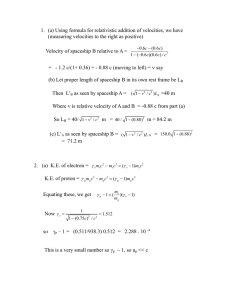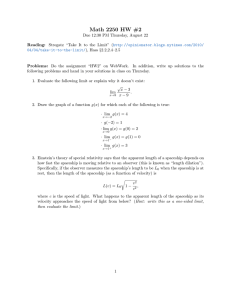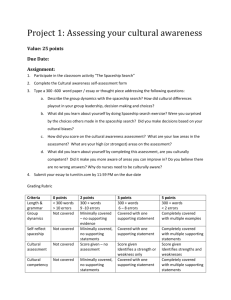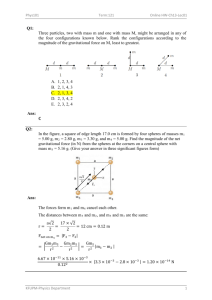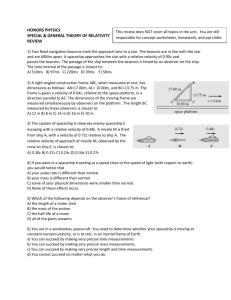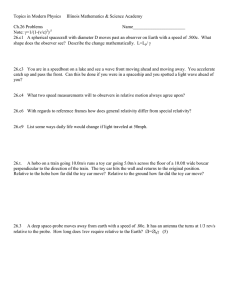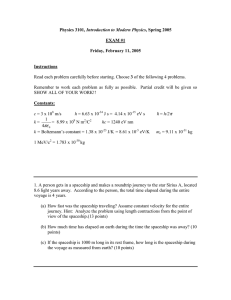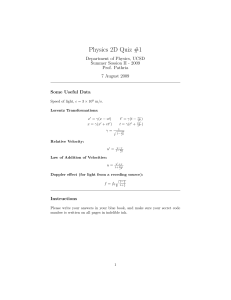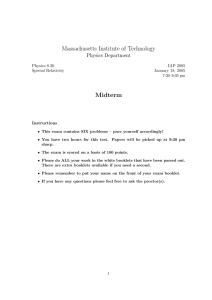Massachusetts Institute of Technology FINAL EXAM Physics Department Physics 8.20
advertisement
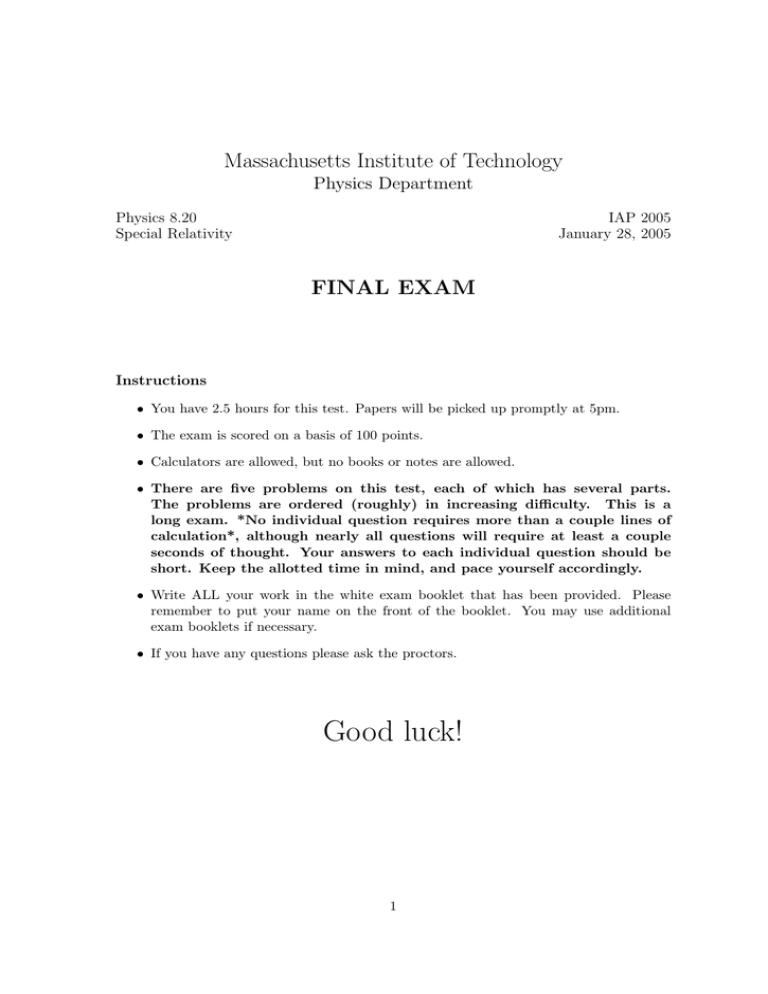
Massachusetts Institute of Technology Physics Department Physics 8.20 Special Relativity IAP 2005 January 28, 2005 FINAL EXAM Instructions • You have 2.5 hours for this test. Papers will be picked up promptly at 5pm. • The exam is scored on a basis of 100 points. • Calculators are allowed, but no books or notes are allowed. • There are five problems on this test, each of which has several parts. The problems are ordered (roughly) in increasing difficulty. This is a long exam. *No individual question requires more than a couple lines of calculation*, although nearly all questions will require at least a couple seconds of thought. Your answers to each individual question should be short. Keep the allotted time in mind, and pace yourself accordingly. • Write ALL your work in the white exam booklet that has been provided. Please remember to put your name on the front of the booklet. You may use additional exam booklets if necessary. • If you have any questions please ask the proctors. Good luck! 1 2 Information Useful approximations: c ≈ 3 · 108 m/s 1 year ≈ π × 107 s Boost (along the x­axis) and its inverse. Suppose V = (v0 , vx , vy , vz ) is a four vector. Then vx� = γ(vx − βv0 ) vx = γ(vx� + βv0� ) vy� = vy vy = vy� vz� = vz vz = vz� v0� = γ(v0 − βvx ) v0 = γ(v0� + βvx� ) � where β = v/c, and γ = 1/ 1 − β 2 . Velocity addition (relative motion along the x­axis): ux − v 1 − ux v/c2 uy u�y = γ(1 − ux v/c2 ) uz u�z = γ(1 − ux v/c2 ) u�x = Lorentz transformation of acceleration: The αx and αy be the components of the acceleration of an object in its instantaneous rest frame, Σ� , which has velocity v in the x­direction as observed in Σ. dvx 1 = 3 αx dt γ (v) dvy 1 ay = = 2 αy dt γ (v) ax = Uniform acceleration: t, x, β, and γ refer to the lab frame; τ is the proper time of the accelerated observer. g is the proper acceleration. β(t) = x2 (t) − c2 t2 = t = gt/c � 1 + (gt/c)2 c4 c2 � 1 + (gt/c)2 or x = g2 g c sinh(gτ /c) g 3 Doppler shift: Longitudinal � ν= 1+β ν0 1−β ν= � 1 − β 2 ν0 Transverse Relativistic energy and momentum: p� = mγ�v E = mγc2 E 2 = p2 c2 + m2 c4 K.E. = E − mc2 Quadratic equation: ax2 + bx + c = 0 � � 1 � x= −b ± b2 − 4ac 2a Binomial expansion: (1 + a)b = 1 + ba + b(b − 1) 2 a + ... 2 Approximations: For � � 1, 1 ≈1+� 1−� √ 1−�≈1− � 2 Hyperbolic functions: sinh x = ex − e−x , 2 cosh x = ex + e−x , 2 tanh x = Identities: cosh2 x − sinh2 x = 1, 1 − tanh2 x = ex − e−x ex + e−x 1 cosh2 x 4 1. [30 points] Short answer questions (a) [2 points] Special Relativity is all about one fundamental physical constant. Which constant? What are its units? In what physical situations do we expect the effects of Special Relativity to be important? (b) [2 points] Define inertial frame. (c) [2 points] Write the four components of 4­velocity, specifying in words any sym­ bols you use. (d) [2 points] Jerk, the third derivative of position with respect to time, is a quantity often used by transportation engineers. Generalizing jerk to 4­jerk (in the same way we have generalized velocity to 4­velocity), write each of the four components of 4­jerk, specifying in words any symbols you use. (e) [2 points] Define proper acceleration. (f) [2 points] Write the special relativistic version of Newton’s second law. (g) [2 points] Write the invariant scalar product a·b of two 4­vectors a = (a0 , a1 , a2 , a3 ) and b = (b0 , b1 , b2 , b3 ) in terms of their components. (h) [2 points] Graph the energy E of an object with mass m as a function of its velocity v. (i) [2 points] Graph the energy E of an object with mass m as a function of its momentum p. (j) [2 points] A periodic light signal is emitted with frequency ν0 in the rest frame of the source. Graph as a function of β the frequency ν of the signal recorded by an observer moving away from the source with relative speed βc, for both positive and negative values of β. (k) [2 points] State the Equivalence Principle, the basic postulate of General Rela­ tivity. (l) [2 points] Can Special Relativity describe the motion of objects undergoing ac­ celeration? Provide a one sentence explanation. (m) [3 points] List three experimental results that are consistent with the predictions of Special Relativity, but inconsistent with the predictions of Galilean Relativity. (n) [3 points] List three experimental results that are consistent with the predictions of General Relativity, but inconsistent with the predictions of Special Relativity + Newton’s Law of Gravitation. 5 2. [15 points] Muon decay in flight The average lifetime of muons at rest is τµ � = 2.2 µs. A laboratory measurement on the decay in flight of muons in a beam emerging from a particle accelerator yields an average lifetime of τµ = 6.6 µs, as measured in the lab frame Σ. [Hint: Work this and subsequent problems in terms of symbols, inserting numbers only as a last step. Full credit will be given for approximate mental math, if you do not have a calculator. Numerical answers may be expressed in any convenient units — you should not waste time in unit conversion.] (a) [2 points] What is the speed of these muons in the laboratory frame Σ? (b) [2 points] The rest mass of the muon is mµ ≈ 100 MeV/c2 (= 108 eV/c2 ). What is the energy of the muons in their rest frame Σ� ? (c) [2 points] What is the energy of the muons in the laboratory frame Σ? (d) [2 points] What is the kinetic energy of the muons in the laboratory frame Σ? (e) [2 points] What is the momentum of the muons in the laboratory frame Σ? (f) [2 points] How far on average do the muons travel before decaying in the labo­ ratory frame Σ? (g) [3 points] Given a large ensemble of these muons, some of the muons will travel farther than others in the laboratory frame Σ. The average distance traveled is the number you found in part (f). Graph the distribution of the distances traveled in the laboratory frame Σ by this ensemble of muons. Carefully label your axes, and show both horizontal and vertical scales. 6 3. [15 points] Neutron shoot­out George and John are two presidential candidates and physics experimentalists at rest with respect to one another at different points in space. They fire neutrons at each other, each neutron leaving its gun with speed of v = 0.6c relative to the gun. For each of the observations below made by John about what is going on, state the corresponding observation that would be reported by a news anchorman (Peter) who is in a frame Σ� chosen such that George’s neutrons are at rest in Σ� . (a) [3 points] “My separation from George is 10 km.” [Hint: Your answer should be of the form: “John’s separation from George is . . . .”] (b) [3 points] “The speed of the neutrons coming from my gun is v = 0.6c.” (c) [3 points] “I am firing neutrons at a rate of 10 kHz.” (d) [3 points] “Two of our neutrons have collided; relativistic momentum and kinetic energy are conserved.” (e) [3 points] “After this collision, one of the neutrons is scattered through an angle of 30◦ .” 7 4. [20 points] Spaceship pursuit Consider two spaceships A and B. Spaceship A is chasing Spaceship B. The ships start out at rest in Σ, the inertial rest frame of our Sun. Place the origin of Σ at the center of the Sun. Supposing Earth and Mars to be aligned, direct the x̂ axis from the Sun through Earth and Mars, and out beyond the Solar System. This problem involves motion along only one spatial dimension. Spaceship B blasts off from Mars at time t = 0 (as measured in the frame Σ), headed out of the Solar System along the x axis. At the same time t = 0 (as measured in Σ), Spaceship A blasts off from Earth in pursuit of Spaceship B, traveling along the x axis. At every time t > 0 (as measured in Σ), both Spaceship A and Spaceship B have the same constant proper acceleration g = 10 m/s2 . Ignore the graviational fields of Earth and Mars in this problem. (a) [2 points] Denote by xA (0) the starting position of Spaceship A (measured in the frame Σ), and denote by xB (0) the starting position of Spaceship B (measured in the frame Σ). Provide your best estimate of the value of xA (0), in units of meters. Provide your best estimate of the value of xB (0), in units of meters. (b) [3 points] Write the equation of motion specifying the position xA (t) of Spaceship A at time t (as measured in Σ). Similarly, write the equation of motion specifying the position xB (t) of Spaceship B at time t (as measured in Σ). (c) [3 points] Draw the world lines of spaceships A and B on a spacetime diagram in the frame Σ, labeling any noteworthy spacetime points. (d) [2 points] How far apart (as measured in Σ) are the two spaceships at time t (as measured in Σ)? (e) [3 points] Now boost to the inertial frame Σ� in which Spaceship A is instanta­ neously at rest at some arbitrary time t1 (as measured in Σ). Draw the diagram you drew in part (c), adding to it the axes ct� and x� . Be careful! Is it possible to choose the origin of Σ� so that x = x� = 0 at t = t� = 0? (f) [3 points] Consider the asymptotic trajectories of the spaceships. As measured in Σ� , the inertial frame in which Spaceship A is instantaneously at rest at some large time t� (as measured in Σ� ), how does the distance between Spaceship A and Spaceship B compare to their starting separation at time t = 0? Larger? Smaller? Equal? You can make your argument geometrically, by considering your carefully drawn Minkowski diagram from part (e). [Note that the inertial frame in which Spaceship A is instantaneously at rest at time t = 0 is the same as the inertial frame Σ in which the Sun is at rest, apart perhaps from a difference of origin, since at time t = 0 Spaceship A is at rest with respect to the Sun.] (g) [1 point] Give a convincing one­sentence explanation of your answer to part (d). (h) [1 point] Give a convincing one­sentence explanation of your answer to part (f ), in terms of simultaneity. (i) [1 point] Will Spaceship A catch Spaceship B? (j) [1 point] Does the question of whether Spaceship A will catch Spaceship B depend on the reference frame? 8 5. [20 points] Fermilab Tevatron The Fermilab Tevatron, a circular accelerator located 50 miles west of Chicago, can accelerate a proton p to an energy of Ep ≈ 1 TeV = 1012 eV (as measured in the lab frame Σ). The energy of a proton at rest is mp c2 ≈ 1 GeV = 109 eV. [Hint: Work the questions below using symbols. Numerical answers are only necessary in part (a), and as you deliberate parts (f) and (g).] (a) [3 points] A fully accelerated proton in the Fermilab Tevatron is traveling at speed v (as measured in the lab frame Σ) very close to the speed of light c. What is c − v, in units of miles per hour (or meters per second)? (b) [3 points] What force (as measured in the lab frame Σ) must be applied by the magnets in the accelerator to keep protons at this speed traveling in a circle, with radius R = 1 km? (c) [3 points] What is the acceleration a� that a proton experiences due to this force, as measured in the instantaneous rest frame Σ� of the proton? (d) [5 points] If a proton p with energy Ep (as measured in the lab frame Σ) collides with a proton in a hunk of metal, at rest in the lab frame Σ, to produce a never­ before­seen particle X through the reaction p + p → X, what is the maximum possible rest mass mX of this particle X ? (e) [4 points] The anti­proton p̄ has rest mass equal to that of the proton p, so that mp̄ c2 = mp c2 ≈ 1 GeV. If a proton p with energy Ep (as measured in the lab frame Σ) collides head­on with an anti­proton p̄ of the same energy Ep traveling in the opposite direction to produce a never­before­seen particle X through the reaction p + p → X, what is the maximum possible rest mass mX of this particle X? (f) [1 point] Suppose the next big breakthrough in particle physics is thought to involve a new particle X with rest energy mX c2 equal to a few hundred GeV (precise value unknown). From your responses above, do you want to (i) zing protons of energy 1 TeV into hunks of metal fixed in the lab frame, (ii) collide protons of energy 1 TeV head­on with anti­protons of energy 1 TeV at the Fermilab Tevatron, or (iii) build a gigantic new collider in Switzerland capable of colliding protons against protons at proton energies of 7 TeV? (g) [1 point] Does your response to the previous question change if you know that it is actually a single quark in the proton (and a single anti­quark in the anti­ proton) that collide, and that each quark (anti­quark) carries only about 20% of the energy of the proton (anti­proton)? Roughly 103 experimental particle physicists around the world are planning their next five years of research based on (f) and (g), as they decide when to move their research from the Fermilab Tevatron to the Large Hadron Collider being built on the France­Switzerland border.
